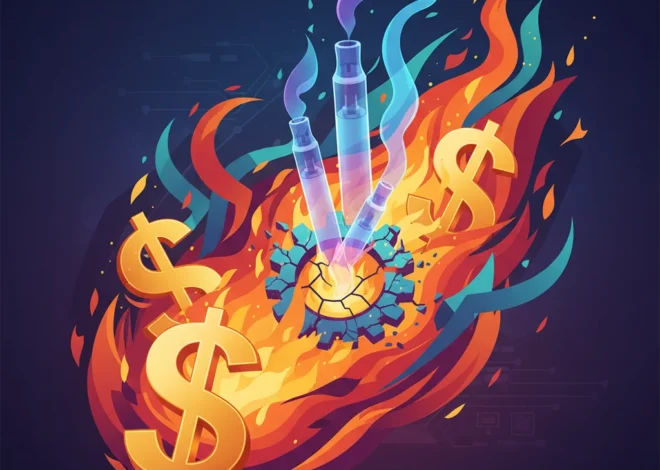
From the Arctic to the Trading Floor: The Investment Case for Radical Sustainability
In the unforgiving landscapes of the Arctic, equipment isn’t a luxury; it’s a lifeline. Every seam, zipper, and strap is tested against nature’s harshest elements. Now, imagine a backpack born from this environment, engineered for ultimate resilience, that looks just as at home in a Wall Street boardroom. This is the compelling narrative behind Groundtruth, a company founded by sisters Sophia, Georgia, and Nina Scott, whose line of high-performance bags is challenging our perceptions of what sustainable products can achieve.
Their flagship product, the RIKR 24L backpack, is not merely an accessory. It’s a statement piece forged from 100% recycled materials, a testament to a new paradigm in manufacturing and design. But beyond its rugged elegance lies a much deeper story—one that intersects with the future of the global economy, modern finance, and the very principles of long-term value investing. This isn’t just about a bag; it’s about a business model that represents a powerful investment thesis for the 21st century.
The Genesis of a Sustainable Powerhouse
The story of Groundtruth begins not in a design studio, but on the front lines of climate change. The Scott sisters, with their background in documentary filmmaking, have witnessed firsthand the environmental degradation plaguing our planet. This experience ignited a mission: to create products that are part of the solution, not the problem. Their answer was to build a company from the ground up based on the principles of the circular economy.
Every Groundtruth bag is constructed from their bespoke GT-RK-001 textile, a technical fabric developed in partnership with a bluesign® certified textile manufacturer in Taiwan. This material is woven from 100% recycled PET plastic bottles, transforming post-consumer waste into a durable, water-resistant, and aesthetically pleasing fabric. According to the original report, the RIKR backpack alone removes approximately 120 plastic bottles from our environment. This commitment extends to every component, from recycled nylon zippers to algae-based foam padding, creating a product that is as environmentally conscious as it is robust.
Beyond Products: Embracing the Circular Economy
Groundtruth’s approach is a masterclass in the principles of the circular economy, a concept that is rapidly moving from academic theory to a cornerstone of modern economics. Unlike the traditional linear model of “take-make-dispose,” the circular model is regenerative by design, aiming to eliminate waste and keep materials in use for as long as possible.
This shift has profound implications for businesses and investors. By designing products for longevity and utilizing waste streams as raw materials, companies can decouple revenue growth from resource consumption, creating more resilient and efficient supply chains. The table below illustrates the fundamental differences between these two economic models:
| Aspect | Linear Economy (Traditional Model) | Circular Economy (Groundtruth’s Model) |
|---|---|---|
| Core Principle | Take, Make, Dispose | Reduce, Reuse, Recycle, Regenerate |
| Resource View | Finite, to be extracted and consumed | Renewable or recycled, to be kept in circulation |
| Product Lifecycle | Designed for obsolescence | Designed for durability, repair, and recycling |
| Economic Driver | Volume of sales | Value preservation and service models |
| Financial Risk | High exposure to resource price volatility | Reduced dependency on virgin raw materials |
For investors, a company operating within a circular framework presents a compelling value proposition. It suggests lower long-term material costs, reduced regulatory risk associated with waste and emissions, and enhanced brand equity among an increasingly eco-conscious consumer base. This is the new frontier of alpha generation in the stock market.
The Investor’s Perspective: Why Sustainability is the New Bull Market
The principles embodied by Groundtruth are precisely what the modern investment world is searching for. The global focus on ESG criteria has exploded, with assets in ESG funds projected to exceed $53 trillion by 2025, representing more than a third of total assets under management. This is not a fleeting trend; it is a fundamental re-evaluation of how we define corporate value.
For finance professionals, from analysts to portfolio managers, a company like Groundtruth ticks several critical boxes:
- Supply Chain Resilience: By relying on recycled materials, the company is less susceptible to the price shocks and geopolitical risks associated with virgin resource extraction. This creates a more predictable and stable cost structure.
- Brand Equity and Market Positioning: In a crowded consumer market, a powerful and authentic mission is a significant differentiator. This translates into stronger customer loyalty, premium pricing power, and organic marketing reach.
- Regulatory Tailwinds: As governments worldwide implement stricter environmental regulations, from carbon taxes to extended producer responsibility laws, companies with built-in sustainability are future-proofed against a significant class of business risk.
While Groundtruth remains a private company, its business model serves as a blueprint for what public market investors are increasingly rewarding. We see this on the stock market every day, where companies with high ESG ratings often command higher valuation multiples and demonstrate lower costs of capital. The era of prioritizing short-term profits at the expense of long-term sustainability is drawing to a close, driven by a powerful confluence of investor demand and economic reality.
Verifying the Vision: The Role of Fintech and Blockchain
One of the greatest challenges in the world of sustainable finance is verification. How can an investor, a bank, or a consumer be certain that a product is truly made from 100% recycled materials? This is where the intersection of sustainability and financial technology (fintech) becomes revolutionary, with blockchain technology leading the charge.
Imagine a future where every Groundtruth backpack comes with a QR code. Scanning it reveals an immutable, blockchain-verified ledger detailing the product’s entire journey. You could see:
- The exact collection point of the plastic bottles.
- The energy consumption data from the recycling facility.
- The batch number of the GT-RK-001 textile created from those bottles.
- The ethical audit reports from the assembly factory.
This level of radical transparency, powered by blockchain, moves a company’s claims from the realm of marketing to the world of verifiable fact. For the banking and investing sectors, this is a game-changer. It allows for the creation of sophisticated new financial instruments: green bonds tied to verified waste reduction, sustainability-linked loans with interest rates that adjust based on blockchain-audited ESG metrics, and algorithmic trading strategies that can automatically reward verifiably sustainable companies.
The Macro-Economic Imperative
The success of ventures like Groundtruth is not happening in a vacuum. It is a direct response to a seismic shift in consumer behavior and a growing recognition of the economic costs of environmental neglect. A 2021 study by the World Wildlife Fund found that online searches for sustainable goods have increased globally by 71% in five years. This consumer demand is a powerful economic force, compelling legacy brands to adapt or risk obsolescence.
This shift creates a virtuous cycle. As consumers vote with their wallets, companies are incentivized to invest in sustainable innovation. This, in turn, creates new markets and opportunities that attract investment capital. The role of the financial sector—from venture capital firms funding the next Groundtruth to large institutional investors allocating capital on the public markets—is to identify and fuel these engines of the new economy.
Conclusion: Investing in the Future, One Backpack at a Time
Groundtruth’s journey from the Arctic to the global marketplace is a powerful allegory for the future of business. It demonstrates that performance and purpose, profit and planet, are not mutually exclusive but are, in fact, deeply intertwined. The RIKR 24L backpack is more than an impressive piece of gear; it is a tangible asset built on the principles of a more resilient, efficient, and sustainable economic model.
For the investor, the finance professional, and the business leader, the lesson is clear. The companies that will define the next generation of economic growth will be those that, like Groundtruth, understand that the most valuable innovations are those that solve real-world problems. By turning plastic waste into premium products, they have not only created a successful business but have also provided a compelling case for why the future of smart investing is inextricably linked to the health of our planet.


